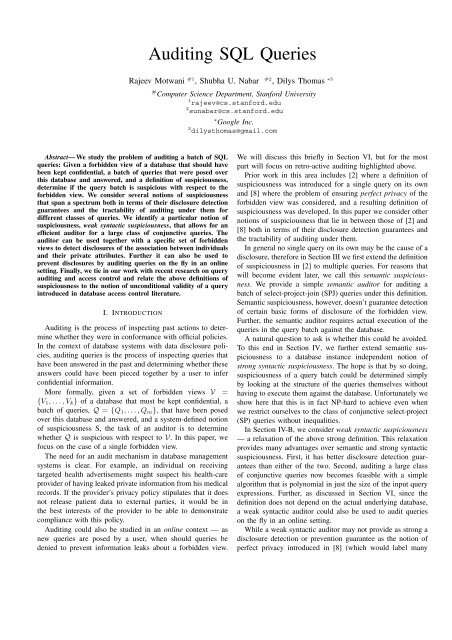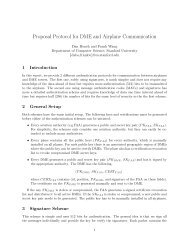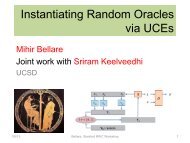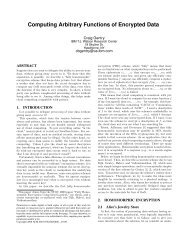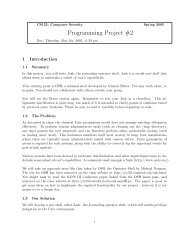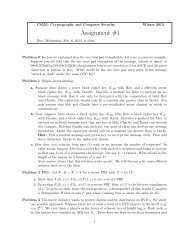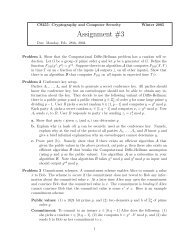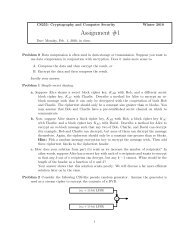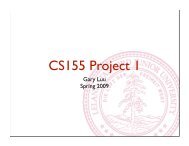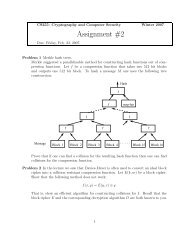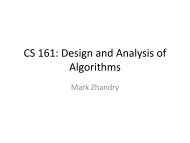Auditing SQL Queries - Stanford Crypto Group - Stanford University
Auditing SQL Queries - Stanford Crypto Group - Stanford University
Auditing SQL Queries - Stanford Crypto Group - Stanford University
You also want an ePaper? Increase the reach of your titles
YUMPU automatically turns print PDFs into web optimized ePapers that Google loves.
<strong>Auditing</strong> <strong>SQL</strong> <strong>Queries</strong><br />
Rajeev Motwani #1 , Shubha U. Nabar #2 , Dilys Thomas ∗3<br />
Abstract— We study the problem of auditing a batch of <strong>SQL</strong><br />
queries: Given a forbidden view of a database that should have<br />
been kept confidential, a batch of queries that were posed over<br />
this database and answered, and a definition of suspiciousness,<br />
determine if the query batch is suspicious with respect to the<br />
forbidden view. We consider several notions of suspiciousness<br />
that span a spectrum both in terms of their disclosure detection<br />
guarantees and the tractability of auditing under them for<br />
different classes of queries. We identify a particular notion of<br />
suspiciousness, weak syntactic suspiciousness, that allows for an<br />
efficient auditor for a large class of conjunctive queries. The<br />
auditor can be used together with a specific set of forbidden<br />
views to detect disclosures of the association between individuals<br />
and their private attributes. Further it can also be used to<br />
prevent disclosures by auditing queries on the fly in an online<br />
setting. Finally, we tie in our work with recent research on query<br />
auditing and access control and relate the above definitions of<br />
suspiciousness to the notion of unconditional validity of a query<br />
introduced in database access control literature.<br />
I. INTRODUCTION<br />
<strong>Auditing</strong> is the process of inspecting past actions to determine<br />
whether they were in conformance with official policies.<br />
In the context of database systems with data disclosure policies,<br />
auditing queries is the process of inspecting queries that<br />
have been answered in the past and determining whether these<br />
answers could have been pieced together by a user to infer<br />
confidential information.<br />
More formally, given a set of forbidden views V =<br />
{V1,...,Vk} of a database that must be kept confidential, a<br />
batch of queries, Q = {Q1,...,Qm}, that have been posed<br />
over this database and answered, and a system-defined notion<br />
of suspiciousness S, the task of an auditor is to determine<br />
whether Q is suspicious with respect to V. In this paper, we<br />
focus on the case of a single forbidden view.<br />
The need for an audit mechanism in database management<br />
systems is clear. For example, an individual on receiving<br />
targeted health advertisements might suspect his health-care<br />
provider of having leaked private information from his medical<br />
records. If the provider’s privacy policy stipulates that it does<br />
not release patient data to external parties, it would be in<br />
the best interests of the provider to be able to demonstrate<br />
compliance with this policy.<br />
<strong>Auditing</strong> could also be studied in an online context — as<br />
new queries are posed by a user, when should queries be<br />
denied to prevent information leaks about a forbidden view.<br />
# Computer Science Department, <strong>Stanford</strong> <strong>University</strong><br />
1 rajeev@cs.stanford.edu<br />
2 sunabar@cs.stanford.edu<br />
∗ Google Inc.<br />
3 dilysthomas@gmail.com<br />
We will discuss this briefly in Section VI, but for the most<br />
part will focus on retro-active auditing highlighted above.<br />
Prior work in this area includes [2] where a definition of<br />
suspiciousness was introduced for a single query on its own<br />
and [8] where the problem of ensuring perfect privacy of the<br />
forbidden view was considered, and a resulting definition of<br />
suspiciousness was developed. In this paper we consider other<br />
notions of suspiciousness that lie in between those of [2] and<br />
[8] both in terms of their disclosure detection guarantees and<br />
the tractability of auditing under them.<br />
In general no single query on its own may be the cause of a<br />
disclosure, therefore in Section III we first extend the definition<br />
of suspiciousness in [2] to multiple queries. For reasons that<br />
will become evident later, we call this semantic suspiciousness.<br />
We provide a simple semantic auditor for auditing a<br />
batch of select-project-join (SPJ) queries under this definition.<br />
Semantic suspiciousness, however, doesn’t guarantee detection<br />
of certain basic forms of disclosure of the forbidden view.<br />
Further, the semantic auditor requires actual execution of the<br />
queries in the query batch against the database.<br />
A natural question to ask is whether this could be avoided.<br />
To this end in Section IV, we further extend semantic suspiciousness<br />
to a database instance independent notion of<br />
strong syntactic suspiciousness. The hope is that by so doing,<br />
suspiciousness of a query batch could be determined simply<br />
by looking at the structure of the queries themselves without<br />
having to execute them against the database. Unfortunately we<br />
show here that this is in fact NP-hard to achieve even when<br />
we restrict ourselves to the class of conjunctive select-project<br />
(SP) queries without inequalities.<br />
In Section IV-B, we consider weak syntactic suspiciousness<br />
— a relaxation of the above strong definition. This relaxation<br />
provides many advantages over semantic and strong syntactic<br />
suspiciousness. First, it has better disclosure detection guarantees<br />
than either of the two. Second, auditing a large class<br />
of conjunctive queries now becomes feasible with a simple<br />
algorithm that is polynomial in just the size of the input query<br />
expressions. Further, as discussed in Section VI, since the<br />
definition does not depend on the actual underlying database,<br />
a weak syntactic auditor could also be used to audit queries<br />
on the fly in an online setting.<br />
While a weak syntactic auditor may not provide as strong a<br />
disclosure detection or prevention guarantee as the notion of<br />
perfect privacy introduced in [8] (which would label many
seemingly innocuous queries as suspicious), we show in<br />
Section V that in conjunction with a specific set of forbidden<br />
views, it can nevertheless provide a very strong guarantee<br />
that would be sufficient in many practical scenarios when all<br />
we wish to protect is the associations between identifiers and<br />
private attributes. At the same time, the auditor is simple and<br />
works for a very large class of queries.<br />
In Sections VI and VII we summarize the relationships between<br />
the different auditors above and also draw a connection<br />
to another database mechanism for controlling access to data<br />
— namely determining query validity studied in [9], [14], [15],<br />
[13]. The connection is interesting in that ideally a database<br />
system would have both an auditing component as well as an<br />
access control component and it is important to understand the<br />
interaction between the two.<br />
Assumptions: The auditors that we design in the upcoming<br />
sections are able to exactly determine query suspiciousness<br />
only when they operate on duplicate-preserving SPJ<br />
queries and views where the SELECT clause does not contain<br />
distinct and multi-set semantics is used in projection.<br />
We drop the duplicate-preserving qualifier from here on, but<br />
it is assumed as a default. Our suspiciousness definitions,<br />
however, are independent of query semantics, and at the end<br />
of Section IV-B, we briefly consider the guarantees of our<br />
auditors when queries do have a set semantics.<br />
We allow queries with self-joins, but only consider forbidden<br />
views with no self-joins. For ease of exposition, we only<br />
show our results here for queries without self-joins. Unless<br />
otherwise stated, the results can be easily extended.<br />
Furthermore, we make some assumptions about the domain.<br />
Let C be the set of all columns (attributes) across all tables in<br />
the database. For any C ∈C,letdom(C) denote the domain<br />
of column C and let it be of size at least 2. Let dom(T ) denote<br />
the set of possible tuples for a table T that can be obtained<br />
by assigning constants from dom(C) for each column, C,<br />
in T . Thus the value that an attribute of a tuple can take is<br />
not constrained by the values of other attributes. A database<br />
instance is then a multi-set of tuples in dom(T ) for every<br />
possible T that occurs in the database. We next briefly review<br />
relevant past work in auditing.<br />
II. PRELIMINARIES AND RELATED WORK<br />
A. <strong>Auditing</strong> Aggregate <strong>Queries</strong><br />
The problem of auditing queries has been extensively studied<br />
in the context of statistical databases [5], [12], [3], [1],<br />
[4], [6], [11]. Statistical databases allow users to retrieve only<br />
aggregate statistics over subsets of its data. In this paper we<br />
consider only SPJ queries and our work is orthogonal to the<br />
body of work on statistical databases.<br />
B. Perfect Privacy<br />
In [8], [7] the authors consider the problem of ensuring<br />
“perfect privacy”: as a database system reveals various views<br />
of its data, does it disclose any information at all about a secret<br />
view that was required to be kept confidential. This work can<br />
also be cast in the auditing framework proposed in this paper<br />
— the secret view corresponds to the forbidden view in our<br />
scenario, the views of the data that were released correspond<br />
to queries that were answered and the privacy requirement<br />
results in a definition of suspiciousness for identifying queries<br />
that violated the requirement.<br />
Perfect privacy: Let D be a distribution according to<br />
which tuples of the database are drawn. A set of released<br />
views, Q, is said to respect perfect privacy of a forbidden<br />
view, V, if:<br />
PrD{V = V } = PrD{V = V |Q}<br />
PrD{V} is the prior distribution over the forbidden view<br />
and PrD{V |Q} is the posterior distribution given the released<br />
views. Perfect privacy is very strict and results in the following<br />
criterion for query suspiciousness (referred to in this paper<br />
as perfect privacy suspiciousness) for distributions D where<br />
each tuple is included in the database independently with some<br />
probability and queries and views follow set semantics:<br />
Definition 1: (Critical Tuple) A tuple t belonging to the<br />
domain of all possible tuples in the database, is critical for<br />
a query Q, if there exists a possible database instance I for<br />
which Q(I −{t}) = Q(I), i.e., if there exists an instance in<br />
which dropping t makes a difference to the result of Q.<br />
Definition 2: (Perfect Privacy Suspiciousness) A query<br />
batch Q is suspicious with respect to a view V iff some query<br />
Q ∈Qis suspicious. Furthermore Q is suspicious with respect<br />
to to V iff there exists some critical tuple common to both V<br />
and Q.<br />
Disclosure detection guarantee: When queries are audited<br />
under perfect privacy suspiciousness, an unsuspicious<br />
query batch is guaranteed to respect perfect privacy of the<br />
forbidden view, whereas a suspicious query batch violates<br />
it. Even though this guarantee is shown to hold only under<br />
set semantics and for data distributions where a database<br />
instance consists of a set (not a multi-set) of tuples drawn<br />
independently of one another, we still treat it as a candidate<br />
notion of suspiciousness for duplicate preserving queries. We<br />
do not make any claims of its guarantees in this setting. Perfect<br />
privacy suspiciousness is very strict, marking many seemingly<br />
innocuous queries as suspicious. For example:<br />
Consider a hospital database containing the names and<br />
phone numbers of patients and we wish to keep secret<br />
all phone numbers in the database, i.e., the secret view is<br />
πphone(P atients). A query, πname(P atients), asking for the<br />
names of all the patients in the hospital would be considered<br />
suspicious with respect to the secret view even though not<br />
a single phone number was revealed by this query. This is<br />
because every possible tuple in dom(P atients) is critical<br />
to both the query and the secret view. The idea is that by<br />
revealing information about the size of the database, the query<br />
revealed some information about the phone numbers column<br />
and is considered suspicious.<br />
In [7], the authors identify subclasses of conjunctive queries<br />
without inequalities (≤,,=), following set semantics,<br />
for which checking for perfect privacy suspiciousness
is tractable. But users often pose queries with a multi-set<br />
semantics. Is checking perfect privacy suspiciousness simpler<br />
in this scenario? There isn’t an immediately obvious answer<br />
(see end of Section IV-B). Partly due to this, and partly because<br />
of the strictness of the information disclosure requirements of<br />
perfect privacy, we search for other suspiciousness definitions.<br />
C. <strong>Auditing</strong> <strong>SQL</strong> <strong>Queries</strong><br />
In [2] the authors study the problem of determining if any<br />
single query in the query log accessed private information.<br />
The data subject to a disclosure review is specified very<br />
simply through an audit expression that closely resembles a<br />
<strong>SQL</strong> query. In the remainder of this paper, we too use audit<br />
expressions to specify forbidden views:<br />
AUDIT audit list FROM table list<br />
WHERE condition list<br />
The audit expression is viewed as an SPJ query specifying the<br />
forbidden view. The sensitive information is in particular the<br />
audit list columns of the tuples of the forbidden view.<br />
The tuples of interest are identified from the cross-product of<br />
tables in the FROM clause via predicates in the WHERE clause.<br />
The definition of suspiciousness considered in [2] asks for all<br />
queries whose WHERE clause predicates were satisfied by any<br />
of these forbidden tuples and that accessed all of the audit<br />
list columns for that tuple. Formally,<br />
Let Q = πCQ (σPQ (R)) be an SPJ query and A =<br />
πCA (σPA (S)) be an audit expression. Here R and S are the<br />
cross-product of all tables in the FROM clauses of Q and A.<br />
CQ(resp. A) are the columns that are projected out in Q (resp.<br />
A) and PQ(resp. A) are the predicates of Q (resp. A). C∗ Q are<br />
all the column names that appear anywhere in Q.<br />
Definition 3: (Candidate Query) Q is a candidate query<br />
with respect to A, if Q accesses all the audit list<br />
columns: C∗ Q ⊇ CA.<br />
Definition 4: (Indispensable Tuple) Let T be the crossproduct<br />
of some subset of tables in Q and let R ′ be the cross<br />
product of the remaining. Thus T×R ′ = R. A tuple t ∈T<br />
is indispensable to Q if the presence or absence of t makes<br />
a difference to the result of Q, i.e., πCQ (σPQ (T × R′ )) =<br />
πCQ (σPQ (T−{t}×R′ )).<br />
Definition 5: (Suspicious Query) Let T be the cross product<br />
of tables common to A and a candidate query Q. Q is<br />
suspicious for A if they share an indispensable tuple t ∈T.<br />
The idea is that an indispensable tuple for A is one of the<br />
forbidden tuples being subjected to a disclosure review. So<br />
if any one of these tuples is also indispensable for Q, then<br />
Q revealed some information about the forbidden tuple while<br />
accessing all of its audit list columns in the process.<br />
Therefore Q potentially revealed information about the audit<br />
list columns themselves for this forbidden tuple. For example,<br />
consider the audit expression:<br />
AUDIT p.disease FROM Patients p<br />
WHERE p.zipcode = 94305<br />
Under the suspiciousness definition, this expression asks for<br />
queries that returned information about any patient living in<br />
94305 and simultaneously accessed his disease column. Now<br />
consider the query:<br />
SELECT p.zipcode FROM Patients p<br />
WHERE p.disease = ‘diabetes’<br />
If any patient who has diabetes lives in 94305, this query will<br />
be considered suspicious. It would not, however, be suspicious<br />
with respect to the following view:<br />
AUDIT p.zipcode FROM Patients p<br />
WHERE p.disease = ‘hypertension’<br />
This is because this audit expression is only interested in<br />
checking if the zipcode of any patient with hypertension was<br />
revealed. For the class of duplicate-preserving SPJ queries,<br />
the condition of sharing an indispensable tuple translates to<br />
the following: Let T be the cross-product of tables common<br />
to A and a candidate query Q and S ′ and R ′ be the crossproduct<br />
of the remaining tables in A and Q respectively. Q<br />
is suspicious iff σPA (σPQ (T × R′ ×S ′ )) = ∅. Sonowthe<br />
audit process is simple: for every candidate query, Q, inthe<br />
query log, if the result of running σPA (σPQ (T×R′ ×S ′ )) is<br />
non-empty, then Q is suspicious.<br />
Disclosure detection guarantee: The guarantees and<br />
weaknesses of this suspiciousness definition and auditor are<br />
not discussed in [2]. Informally, it detects queries whose<br />
results contain tuples corresponding to forbidden tuples and<br />
that on their own could have leaked information about all<br />
the audit list columns of such a forbidden tuple to<br />
an adversary with no background knowledge of correlations<br />
between tuples or between attributes of the same tuple. We<br />
show that it may not however catch a query that could have<br />
leaked information about the audit list columns of a<br />
forbidden tuple because of the absence of a corresponding<br />
tuple in its results. Consider the following audit expression<br />
and query:<br />
AUDIT P.disease FROM Patients p<br />
WHERE p.name = ‘Alice’<br />
SELECT P.name FROM Patients p<br />
WHERE p.disease = ‘cancer’<br />
If Alice does not have cancer, the query would be considered<br />
safe, although it did reveal that either Alice was not in the<br />
database, or she did not have cancer. Such negative disclosures<br />
are not detected. This is not true for the syntactic notions of<br />
suspiciousness that we propose.<br />
Indispensability and criticality: Note that if a tuple t<br />
is indispensable to a query, then a portion of the tuple t ′<br />
that comes from any single base table is a critical tuple for<br />
the query. This is because in a duplicate-preserving query,<br />
there is a one-to-one correspondence between the number<br />
of input tuples that satisfy its WHERE clause predicates and<br />
the number of output tuples. Removing t ′ from the current<br />
database instance reduces the number of satisfying input tuples<br />
and thus changes the result of the query.
We will now introduce our new notions of suspiciousness,<br />
design auditors for them, and discuss their disclosure detection<br />
guarantees. Please see a technical report at [10] for discussions<br />
and proofs of some of the results that have been omitted here<br />
for lack of space.<br />
III. SEMANTIC AUDITING<br />
The work that we first chose to build on was that of [2]<br />
since the notion of suspiciousness here is more relaxed than<br />
prefect privacy suspiciousness and allows for simpler auditors.<br />
The authors however, only considered detecting queries that<br />
on their own accessed all the forbidden columns of one or<br />
more of the tuples of a forbidden view. In general, no one<br />
query in isolation may have accessed all the audit list<br />
columns of a forbidden tuple, though a few queries together<br />
could have For example, the audit expression might be<br />
AUDIT p.name, p.disease FROM Patients p<br />
WHERE p.zipcode = 94305<br />
Here the data that needs to be kept secret is the association<br />
between names and diseases of patients living in the zipcode<br />
94305. Now consider the <strong>SQL</strong> queries:<br />
SELECT p.zipcode FROM Patients p<br />
WHERE p.disease = ‘diabetes’<br />
SELECT p.name FROM Patients p<br />
WHERE p.zipcode = 94305<br />
Neither query on its own could have revealed the name-disease<br />
association of anyone living in 94305 to an attacker with no<br />
background knowledge of people living in 94305. However<br />
the combination of the queries could have. For instance, if<br />
there was only one patient in 94305 and he had diabetes, then<br />
these queries revealed his name-disease association. There are<br />
subtle ways in which the results of queries could be combined<br />
to reveal information and in the notion of suspiciousness we<br />
introduce here, informally, we seek to capture disclosures of<br />
the audit list columns that could be caused by an attacker<br />
“joining” query results that contain tuples corresponding to<br />
forbidden tuples.<br />
We assume that attackers are powerful and know exactly<br />
which tuples in the results of different queries come from the<br />
same individual and can be “joined”. The resulting suspiciousness<br />
definition is conservative: it may label query batches as<br />
suspicious when a user could not have easily mapped result<br />
tuples to a particular individual in reality.<br />
Since this form of suspiciousness derives meaning from<br />
a particular world view, i.e., the current database state, we<br />
call it semantic suspiciousness. This is in contrast to syntactic<br />
suspiciousness defined later, where suspiciousness of a batch<br />
depends entirely on the structure of the queries in the batch,<br />
not on the actual database state.<br />
Definition 6: (Semantically Suspicious Query Batch) A<br />
query batch Q is semantically suspicious with respect to an<br />
audit expression A if there is some subset of queries Q ′ ⊆Q<br />
and some tuple t ∈T (the cross-product of tables common to<br />
A and every query Q ∈Q ′ ) such that (1) t is indispensable to<br />
both A and every Q ∈Q ′ and (2) the queries in Q ′ together<br />
access all the audit list columns of A.<br />
Semantic suspiciousness is a natural extension of the definition<br />
in [2] and we construct an auditor for it.<br />
Theorem 1: Auditor 1 determines exactly if an SPJ query<br />
batch Q is semantically suspicious with respect to audit<br />
expression A.<br />
Algorithm 1 Semantic Auditor<br />
1: // D=cross-product of tables occurring in A or some Q ∈Q<br />
2: compute V = π∗(σP A (D)) on the given database instance<br />
3: for every query Q ∈Q<br />
4: for every tuple t ∈ V<br />
5: if t satisfies the WHERE clause predicates of Q<br />
6: mark all columns of t accessed by Q<br />
7: if all audit list columns of some t ∈ V are marked<br />
8: return suspicious.<br />
9: else return unsuspicious.<br />
To determine exactly the subset of queries involved in the<br />
disclosure, the auditor can maintain with each marked cell,<br />
the set of queries that accessed it. The cross-product of all the<br />
query sets for each cell of each disclosed tuple gives all the<br />
query subsets Q ′ that could have caused the disclosure.<br />
We omit a proof due to space constraints. The idea is that<br />
if a tuple t ∈ V satisfies the predicates of a set of queries Q ′ ,<br />
then the part of t, t ′ , that comes from the cross-product of<br />
tables common to all queries in Q ′ and A is indispensable<br />
to every query in Q ′ and A. This is because the queries<br />
are duplicate-preserving: every input tuple that satisfies their<br />
predicates results in a corresponding output tuple. So removing<br />
t ′ causes a difference to all the query results.<br />
Note that as in [2], we require the query batch to access all<br />
the audit list columns in order to be even considered for<br />
suspiciousness testing. This is because informally, we would<br />
ideally like to determine “full disclosure” of a forbidden tuple,<br />
i.e., could any combination of queries in the query batch have<br />
revealed all the audit list columns of a forbidden tuple<br />
to an adversary. This is motivated by findings such as in<br />
[16] where attributes such as date-of-birth, gender or zipcode<br />
on their own are not selective, however in conjunction can<br />
uniquely identify individuals. In such a case, revealing the<br />
diseases of all females in a zipcode is likely to be harmless,<br />
however revealing this in conjunction with dates-of-birth could<br />
cause significant privacy breaches.<br />
We discuss the disclosure detection abilities of a semantic<br />
auditor in more detail in Section V. Briefly, just like the auditor<br />
of [2], it does not catch query batches that could have caused<br />
disclosure of the audit list columns due to the absence<br />
of forbidden tuples in query results. In fact the problem of<br />
negative disclosures becomes even more amplified for multiple<br />
queries since many negative disclosures together could add up<br />
to a lot of positive disclosure. It is partly due to this that we<br />
study other definitions of suspiciousness. Another reason is<br />
that executing every single query in Q against the forbidden<br />
view could be an expensive operation if the query log and the<br />
forbidden view are large. In the following section we consider
steps towards eliminating these drawbacks.<br />
IV. SYNTACTIC AUDITING<br />
We define notions of suspiciousness that are independent of<br />
the database instance. The hope is that by eliminating dependence<br />
on underlying data, suspiciousness can be determined<br />
from just the structure of the queries. As an interesting side<br />
effect, syntactic auditors can catch negative disclosures unlike<br />
semantic auditors. We give formal guarantees for certain kinds<br />
of forbidden views in Section V.<br />
A. Strong Syntactic Suspiciousness<br />
Definition 7: (Strong Syntactic Suspiciousness of a Query<br />
Batch) A query batch is strongly syntactically suspicious<br />
with respect to an audit expression if there is some database<br />
instance for which it is semantically suspicious.<br />
Note that the current database tables form an instantiation.<br />
Therefore if a query batch is semantically suspicious with<br />
respect to an audit expression, it is also strongly syntactically<br />
suspicious. A strong syntactic auditor would thus be more<br />
conservative than a semantic auditor.<br />
Unlike semantic auditing, the hope is that checking for<br />
strong syntactic suspiciousness would require the auditor to<br />
only analyze the structure of query expressions in the batch,<br />
not the answers to the queries on the actual database since<br />
suspiciousness is independent of the underlying database. Our<br />
result here is negative, even if we restrict ourselves to just the<br />
class of conjunctive select-project queries without inequalities.<br />
Theorem 2: Testing exactly if a batch of conjunctive SP<br />
queries without inequalities is strongly syntactically suspicious<br />
with respect to an audit expression is NP-hard in the size of<br />
the query expressions.<br />
Weakening this notion of suspiciousness, however, lets us<br />
make positive claims, while providing auditors that would only<br />
be more strict, i.e., all strongly suspicious query batches would<br />
also be classified as weakly suspicious.<br />
B. Weak Syntactic Suspiciousness<br />
Definition 8: (Weak Syntactic Suspiciousness of a Query<br />
Batch) A batch of queries Q is weakly syntactically suspicious<br />
with respect to an audit expression A, if there exists some<br />
subset of the queries Q ′ ⊆ Q and some instantiation of<br />
database tables I such that (1) a tuple t ∈T (the cross-product<br />
of tables common to every Q ∈Q ′ and A) is indispensable to<br />
every Q ∈Q ′ and A in the context of I and (2) the queries in<br />
Q ′ suspiciousness. Note also that the weakening of condition (2)<br />
gives us the following decomposability result.<br />
Theorem 3: An SPJ query batch Q is weakly syntactically<br />
suspicious with respect to an audit expression, A, iffsome<br />
Q ∈Qis weakly syntactically suspicious with respect to A.<br />
Intuitively this is because of the shift in focus from trying<br />
to detect “full disclosures” of the audit list columns<br />
of forbidden tuples to trying to detect “partial disclosures”.<br />
Suspiciousness of a batch can now be tested by testing<br />
suspiciousness of each query on its own (as is true for perfect<br />
privacy suspiciousness). Focusing on partial disclosures gets<br />
us away from the complex issues of how queries could be<br />
combined to reveal information about all the audit list<br />
columns because for a partial disclosure to occur, some query<br />
should have disclosed information about at least one of the<br />
columns to begin with. We formalize the disclosure detection<br />
guarantees of a weak syntactic auditor for a specific set of<br />
forbidden views in Section V, however it is clear that the<br />
following relationship holds:<br />
Theorem 4: Perfect Privacy Suspiciousness ≥ Weak Syntactic<br />
Suspiciousness ≥ Strong Syntactic Suspiciousness ≥<br />
Semantic Suspiciousness.<br />
Here ‘A ≥ B’ means that definition A is stricter than definition<br />
B and therefore all query batches considered suspicious<br />
for a given audit expression by B would also be considered<br />
suspicious by A.<br />
Despite Theorem 3, testing strong syntactic suspiciousness<br />
of an arbitrary SPJ query is still NP-hard in the size of the<br />
query expression. The proof is a straightforward reduction<br />
from 3-SAT.<br />
Theorem 5: Testing weak syntactic suspiciousness of an<br />
arbitrary SPJ query batch with respect to an audit expression<br />
is NP-hard in the size of the query expressions.<br />
A natural question is whether there are classes of queries for<br />
which there exist efficient weak syntactic auditors. We restrict<br />
ourselves to conjunctive SPJ queries and views that do not<br />
contain = predicates between attributes in their WHERE clauses<br />
and show a positive result here. Note that we do allow =<br />
predicates between attributes and constants.<br />
Theorem 6: Let Q be a conjunctive SPJ query batch and<br />
A = πCA (σPA (S)) be a conjunctive SPJ audit expression. If<br />
A and Q have no = predicates between any two attributes in<br />
their WHERE clauses, then Auditor 2 can determine exactly if<br />
together access at least one of the audit list columns. Q is weakly syntactically suspicious with respect to A in time<br />
Note that to arrive at this definition, we simply weakened<br />
polynomial in the size of the query expressions.<br />
condition (2) in the definition of strong syntactic suspicious- First, due to Theorem 3 it suffices to check suspiciousness<br />
ness and thus a query batch that is strongly syntactically of each query in the batch individually. If any one query<br />
suspicious will also be weakly syntactically suspicious. is suspicious, we can mark the entire batch as suspicious.<br />
At this point, the definition may not seem all that different Second, we only check suspiciousness of queries that access at<br />
from perfect privacy suspiciousness, but as we shall see, the least one of the audit list columns of A. Suspiciousness<br />
difference between indispensability and criticality enables us<br />
to design a simple weak syntactic auditor for a large class<br />
of such a candidate query Q is determined by testing if PA and<br />
PQ are compatible, i.e., could any tuple in dom(T ×R<br />
of queries and that cannot be used to detect perfect privacy<br />
′ ×S ′ )<br />
satisfy both PA and PQ. The query is weakly syntactically
Algorithm 2 Skeleton of a Weak Syntactic Auditor<br />
(for conjunctive queries and views, step 3 can be determined in time<br />
polynomial in the size of the query expressions)<br />
1: for every query Q = πC Q (σP Q (R)) ∈Q<br />
2: if C ∗ Q ⊇ CA<br />
3: if ∃ t ∈ dom(T × R ′ ×S ′ ) such that PA(t) =1and<br />
PQ(t) =1<br />
4: return suspicious<br />
5: return unsuspicious<br />
6: //T = cross-product of tables common to Q and A<br />
7: //R ′ , S ′ = cross-products of remaining tables in Q and A<br />
suspicious iff such a tuple exists. This is because Q and A are<br />
duplicate-preserving, ensuring a one-to-one correspondence<br />
between output tuples and input tuples that satisfy their WHERE<br />
clause predicates. So if a t ∈T×R ′ ×S ′ satisfies PQ and PA,<br />
the portion of t that comes from T will be indispensable to<br />
both Q and A in an instance containing that tuple. Likewise,<br />
if a t ∈T is indispensable to both Q and A in an instance<br />
where r ′ ∈R ′ and s ′ ∈S ′ , then t × r ′ × s ′ will satisfy PQ<br />
and PA.<br />
In the case of conjunctive queries and conjunctive views,<br />
this compatibility can be checked in time polynomial in the<br />
size of the query expressions. We omit a full proof for lack<br />
of space, and only briefly discuss how this could be done<br />
for predicates over numerical attributes here: The predicates<br />
could be between two attributes or between an attribute and a<br />
constant. <strong>Group</strong> attributes in to equivalence classes based on<br />
equality predicates between attributes. Then a pass over the<br />
inequality predicates between attributes establishes relationships<br />
between these equivalence classes: Create a graph with<br />
vertices of the graph corresponding to the equivalence classes.<br />
Let EA be the equivalence class to which attribute A belongs.<br />
Then for every constraint of the form A
algorithms for determining perfect privacy suspiciousness for<br />
conjunctive queries that follow set semantics. However they<br />
do not work for queries with inequalities such as query Q<br />
above.<br />
V. DETECTING ASSOCIATION PRIVACY BREACHES<br />
Thus far, we have a definition of suspiciousness for which<br />
a large class of conjunctive queries can be audited in time<br />
polynomial in the size of the query expressions. An important<br />
question that remains is, what kinds of disclosure of the<br />
forbidden view are detected by such a weak syntactic auditor.<br />
We are unable to give guarantees for arbitrary forbidden views:<br />
see the technical report [10] for more of a discussion on<br />
this and formal definitions of the notions of full and partial<br />
disclosure discussed earlier. However for a specific kind of<br />
forbidden view, the weak syntactic auditor gives concrete<br />
guarantees.<br />
Specifically, we consider a common kind of disclosure that<br />
a database system would like to detect: the disclosure of the<br />
association between an individual and his sensitive attributes.<br />
Consider a database with m tables. Let NSi and Si be the<br />
so called “non-sensitive” and “sensitive attributes” of the ith<br />
table, Ti. Suppose each individual in the database has exactly<br />
one tuple in each of these tables. And one such individual,<br />
I, has complained that his sensitive attributes were leaked<br />
and is therefore being subject to a disclosure review. Then<br />
ideally we would like to label a query batch posed in the<br />
past as suspicious if it violates the association privacy of the<br />
individual as defined below.<br />
Definition 9 (Association Privacy Breach): A set of<br />
queries Q violates the association privacy of an individual I,<br />
if there exists some attacker with prior distribution D over<br />
I’s sensitive attributes for whom,<br />
PrD{S(I) =s|Q} = PrD{S(I) =s}<br />
Here S(I) is the concatenation of all the sensitive attributes<br />
of individual I.<br />
Note that the distribution D here is the prior distribution of<br />
the attacker and the definition of the breach considers all such<br />
attackers. On the other hand in the case of perfect privacy,<br />
D was the distribution that the data was drawn from and<br />
an attacker with a prior very different from the true data<br />
distribution could potentially learn a lot from the released<br />
views. In this sense, the notion of association privacy of an<br />
individual is stronger than the notion of perfect privacy.<br />
If we make certain assumptions about the attacker’s prior<br />
distribution D and frame an appropriate set of audit expressions,<br />
then a weak syntactic auditor can be used to detect<br />
association privacy breaches. We frame the following set<br />
of audit expressions that we call association views for k<br />
individuals being subject to a disclosure review:<br />
∀ iin1 ...m<br />
AUDIT Si FROM Ti<br />
WHERE NSi = ns 1 i ∨NSi = ns 2 i ∨ ...∨NSi = ns k i<br />
Here ns j<br />
i are the values of the non-sensitive attributes for<br />
the jth individual in the ith table. Each NSi = ns j<br />
i term is<br />
itself a conjunction of equality predicates on the non-sensitive<br />
attributes of the jth individual.<br />
We make the following (reasonable) assumptions about an<br />
attacker’s prior D: (1) The attacker knew beforehand that the<br />
individuals being subject to the disclosure review were in the<br />
database (2) The attacker knew all the non-sensitive attributes<br />
of the individuals being subject to the disclosure review (even<br />
if he didn’t know them beforehand, he should have been<br />
allowed to learn them by querying the database) (3) He may or<br />
may not have known some of the sensitive attributes of these<br />
individuals beforehand as well (4) He had some prior belief<br />
about correlations between attributes of each individual, but<br />
had no beliefs about correlations between attributes of different<br />
individuals.<br />
Now consider a weak syntactic auditor that labels a query<br />
batch as suspicious if it is suspicious with respect to any one<br />
of the association views 1 . Then:<br />
Theorem 8: If a batch of queries Q violates the association<br />
privacy of some I ∈I, a weak syntactic auditor will label Q as<br />
suspicious with respect to the set of association views for the<br />
individuals I. Further, only the weakly syntactically suspicious<br />
queries within Q can be responsible for the violation.<br />
We call this the association breach detection guarantee. As<br />
an example, consider a hospital database containing two tables,<br />
one with patients’ age, gender, zipcode and disease, the other<br />
with patient names and medications. Medication and disease<br />
are the sensitive attributes of any individual. Suppose that<br />
Alice who is 23 years old and lives in 94305 is in the database<br />
and suspects that her medication or disease information was<br />
leaked by a query batch. Then the set of association views for<br />
Alice are:<br />
AUDIT p.disease FROM Patients p<br />
WHERE p.age = 23 ∧ p.gender = ‘f’ ∧ p.zipcode<br />
= 94305<br />
AUDIT c.medication FROM Customers c<br />
WHERE c.name = ‘Alice’<br />
A semantic auditor would not be able to give an association<br />
breach detection guarantee with respect to the above set of<br />
audit expressions. Consider an attacker who knew Alice was<br />
in the database. Suppose that based on his prior knowledge<br />
of her sensitive attributes and complete knowledge of her<br />
non-sensitive attributes, he had known that she took either<br />
tylenol or aspirin or advil with equal probability. If she took<br />
tylenol, then he knew that she has headaches, if she took advil<br />
then he knew that she either has headaches or backaches with<br />
equal probability and if she took aspirin then she either has<br />
headaches or heart disease with equal probability. Consider<br />
1 Although each audit expression in the set of association views is not<br />
conjunctive, Auditor 2 could easily be adapted to audit conjunctive queries<br />
with respect to each disjunctive audit expression in time polynomial in the<br />
size of the query expressions by checking for compatibility of the WHERE<br />
clause predicates of a query with each disjunct of the WHERE clause of the<br />
audit expression.
the following queries:<br />
SELECT c.name FROM Customers c<br />
WHERE c.medication = ‘tylenol’<br />
SELECT c.name FROM Customers c<br />
WHERE c.medication = ‘advil’<br />
If Alice takes aspirin, she is not an indispensable tuple for<br />
either query and the query batch would be considered semantically<br />
unsuspicious whereas in reality by virtue of multiple<br />
negative disclosures, it revealed that Alice did in fact take<br />
aspirin and that she either has headaches or heart disease.<br />
However a weak syntactic auditor would label the query batch<br />
as suspicious. In fact, each query in the batch would be<br />
considered suspicious in its own right due to the indispensability<br />
of Alice’s tuple in some database instance; observe that<br />
both queries should in fact be considered suspicious since the<br />
answer to either query changes the attacker’s distribution on<br />
Alice’s medication and diseases.<br />
For further discussion on why the association breach detection<br />
guarantee does not hold for attackers with prior knowledge<br />
of correlations across individuals, and a discussion on other<br />
kinds of association views that can be framed, see our technical<br />
report at [10].<br />
That said, weak syntactic suspiciousness does not provide<br />
as strong disclosure detection guarantees as perfect<br />
privacy suspiciousness even in the absence of correlations<br />
across individuals. In the example from Section II, the query<br />
πname(P atients) would be suspicious under perfect privacy<br />
in case the secret view is πphone(P atients), whereas a weak<br />
syntactic auditor would deem it unsuspicious, thereby letting<br />
slip the revelation of the size of the forbidden view. But<br />
besides forbidden view sizes, is there any other information<br />
disclosure that such an auditor would not detect? It would<br />
be interesting to characterize exactly the kinds of disclosure<br />
detected under the different definitions and to explore other<br />
definitions in this space.<br />
VI. ONLINE AUDITING<br />
Other than detecting disclosures that have already occurred,<br />
a potentially important use of an auditor could be to prevent<br />
disclosures from taking place. An auditor could be used to<br />
determine whether a query should be denied in order to prevent<br />
a user from learning information about the forbidden view.<br />
Could the auditors we described above be used in an online<br />
setting?<br />
The notion of semantic suspiciousness and a semantic<br />
auditor don’t really make sense in an online setting because<br />
the act of denying a query itself could reveal information to<br />
a user that the auditor was seeking to protect. For example,<br />
consider the following forbidden view:<br />
AUDIT p.name, p.disease FROM Patients p<br />
WHERE p.zipcode = 94305<br />
Now suppose the following query is permitted by a semantic<br />
auditor and it returns only one disease.<br />
SELECT p.disease FROM Patients p<br />
WHERE p.zipcode = 94305<br />
But the following query is denied<br />
SELECT p.name From Patients p<br />
WHERE p.zipcode = 94305 and p.name = ‘Alex’<br />
The only reason that this could happen is that Alex who lives<br />
in 94305 is actually in the database and his disease was the<br />
one returned by first query. Even though the second query<br />
was denied, the name-disease association of an individual in<br />
the forbidden view was revealed. This is because the auditor’s<br />
reasoning process for the denial involved the answer to the<br />
second query which was information that was unavailable to<br />
the adversary prior to the denial.<br />
On the other hand, if all we wish to protect is the association<br />
privacy of individuals and their sensitive attributes, and are<br />
satisfied with the association breach detection guarantee of<br />
Theorem 8, a weak syntactic auditor could be used in conjunction<br />
with the association views of Section V in an online<br />
fashion. Suspicious queries would be denied, unsuspicious<br />
queries would be answered, and an attacker would not learn<br />
a posterior distribution over the sensitive attributes of any one<br />
individual that is different from his prior. In particular, let Q =<br />
{q1,...,qt} be a sequence of queries and A = {a1,...,at}<br />
be the answers supplied by the weak syntactic auditor. Here<br />
each ai is either the true query result of qi over the database<br />
or a denial. Then for each individual I ∈ I we can show<br />
that for any attacker with a prior distribution D satisfying the<br />
conditions enumerated in Section V,<br />
PrD{S(I) =s|q1,...,qt,a1,...,at} = PrD{S(I) =s}<br />
In this scenario, denials do not leak additional information<br />
because the decision to deny a query is not based on the<br />
actual database state. Suspicious queries are determined by<br />
considering all possible database instances and not by using<br />
any information that is unavailable to an adversary. The<br />
adversary can himself carry out the auditor’s reasoning process<br />
and predict when his queries will be denied.<br />
Also note that due to the decomposability result of Theorem<br />
3, suspiciousness of a query can be determined independently<br />
of all past queries and thus the auditor need not<br />
maintain an audit trail of all past queries posed. In the interests<br />
of avoiding a very draconian denial policy, it would be worth<br />
exploring relaxations of weak syntactic suspiciousness that<br />
permit a bounded change in an attacker’s posterior distribution<br />
on the sensitive attributes of an individual for an association<br />
breach detecting set of audit expressions. This is a very<br />
interesting avenue for future research.<br />
VII. AUDITING AND ACCESS CONTROL<br />
As we have seen, previous work in [8], [2] can be cast in<br />
the auditing framework proposed in this paper. The differences<br />
lie in the definitions of suspiciousness<br />
In database access control literature, the problem studied<br />
is essentially the dual of the auditing problem: Given a set<br />
of “authorization views”, V = {V1,...,Vk} for a user and
a definition of validity, what queries posed by the user are<br />
valid with respect to the authorization views and are therefore<br />
safe to answer? Here the authorization views correspond to<br />
information that the user is allowed to access and they can be<br />
specified via <strong>SQL</strong> queries similar to audit expressions. One<br />
notion of validity considered in particular in [9], [14], [15],<br />
[13] is that of unconditional validity:<br />
Definition 10: (Unconditionally Valid Query) Given a set of<br />
authorization views, V, a query Q is unconditionally valid with<br />
respect to V if there is a query Q ′ that can be written using<br />
only the instantiated authorization views and is equivalent to<br />
Q, i.e., Q ′ produces the same result as Q on all database<br />
instances.<br />
We now formalize the relationship between unconditional<br />
validity and suspiciousness of a query. We use the notation<br />
P (t) =1to denote that tuple t satisfies predicates P . We first<br />
start off with the following simple result relating unconditional<br />
validity to perfect privacy suspiciousness in case of a database<br />
containing a single table.<br />
Theorem 9: Given a forbidden view with no self joins<br />
A = πCA (σPA (T )), there exists an authorization view over<br />
the database such that a query with no self joins Q =<br />
πCQ (σPQ (T )) is suspicious with respect to A under perfect<br />
privacy suspiciousness iff it is not unconditionally valid with<br />
respect to the authorization view.<br />
The intuition behind this and the next result is that the<br />
forbidden view implicity defines a set of authorization views<br />
that are essentially its complement. In this case the implicit<br />
authorization view is V = π∗(σPA ¯ (T )).<br />
We can also show the following result relating unconditional<br />
validity to weak syntactic suspiciousness.<br />
Theorem 10: Consider a conjunctive forbidden view A =<br />
πCA (σPA (T×S)) with no self joins such that CA ∩CPA = ∅.<br />
Here CPA refers to the columns accessed by PA.<br />
Consider any conjunctive query A = πCQ (σPQ (T × R))<br />
with no self joins such that if CA ∩ CPQ = ∅ then if ∃t ∈<br />
dom(T × R × S) such that PA(t) =1∧ PQ(t) =1then<br />
∃t ′ ∈ dom(T ×R×S) such that PA(t ′ )=1∧ PQ(t ′ outside of zipcode 94305. The corresponding authorization<br />
views would then be<br />
V 1: SELECT * FROM Patients p<br />
WHERE p.zipcode = 94305<br />
V 2: SELECT * \ p.disease FROM Patients p<br />
WHERE p.zipcode = 94305<br />
Here the \ in the SELECT clause of V 2 is the set difference<br />
operator, i.e., V 2 selects all but the disease column. Consider<br />
the query:<br />
Q: SELECT p.zipcode FROM Patients p<br />
WHERE p.disease = ‘cancer’<br />
Q is clearly weakly syntactically suspicious with respect to<br />
the forbidden view because there could be a database instance<br />
where an individual with cancer lives outside of area code<br />
94305. Further Q cannot be rewritten as Q<br />
) = 1.<br />
There exist a set of authorization views, V, over the database<br />
such that every such Q is weakly syntactically suspicious with<br />
respect to A iff it is not unconditionally valid w.r.t. V.<br />
The condition on the query in the statement of the theorem<br />
essentially requires that the predicates of a query that accesses<br />
any of the audit list columns of the audit expression<br />
should not be vacuous with respect to forbidden tuples, i.e., it<br />
shouldn’t be the case that all forbidden tuples in the domain<br />
of possible tuples satisfy the query predicates. We illustrate<br />
this condition and the theorem with an example. Consider the<br />
following forbidden view<br />
AUDIT p.disease FROM Patients p<br />
WHERE p.zipcode = 94305<br />
The forbidden view thus says that a user does not have a<br />
right to learn the disease information of any individual living<br />
′ over V 1 and<br />
V 2 such that the answer to Q ′ is the same as the answer<br />
to Q for every possible database instance. This is because<br />
patients living outside of 94305 could either have or not have<br />
cancer (due to our assumptions on the domain) and V 2 does<br />
not provide access to their disease column. Thus Q is not<br />
unconditionally valid with respect to V 1 and V 2. Nowthe<br />
condition on the query and domain must make some sense. If<br />
the domain was known to be such that every single person<br />
living outside of 94305 could only have cancer, then the<br />
authorization views, the way we have designed them would<br />
essentially be hiding no information from a user at all. On the<br />
other hand a query such as<br />
SELECT p.phonenumber FROM Patients p<br />
is not suspicious with respect to the forbidden view and also<br />
can be rewritten over the authorization views as<br />
SELECT p.phonenumber FROM V 1<br />
UNION<br />
SELECT p.phonenumber FROM V 2<br />
The above theorems are interesting as they tie together<br />
work in auditing and work in the database access control<br />
literature. Mechanisms that are used for detecting validity of<br />
an SPJ query could potentially also be used for detecting<br />
suspiciousness of SPJ queries in some cases. Ideally a database<br />
management system would try to incorporate both mechanisms<br />
- a database access control mechanism that gives users access<br />
to various parts of the data, thereby providing utility, and an<br />
auditing mechanism (perhaps an online auditing mechanism)<br />
to detect or prevent privacy breaches. An interesting avenue<br />
for future work would be to see how both these mechanisms<br />
could be combined in a system to work together. Checking<br />
for consistency in such a system would then be an interesting<br />
question, i.e., for a set of forbidden views, a notion of suspiciousness,<br />
a set of authorization views and a notion of validity,<br />
is it the case that every suspicious query is invalid and every<br />
valid query is not suspicious. Another interesting question to<br />
ask would be for a given level of privacy (forbidden views<br />
and definition of suspiciousness), what is the maximum utility<br />
one could have while maintaining consistency and vice versa.
We have only just scratched the surface of this connection so<br />
far, and for most definitions and query classes, the questions<br />
remains wide open.<br />
VIII. CONCLUSIONS<br />
In this paper we introduced a framework for auditing queries<br />
and several different notions of suspiciousness that differed in<br />
their disclosure detection guarantees as well as the tractability<br />
of auditing under them for different classes of queries. Out<br />
of all these the notion of weak syntactic suspiciousness had<br />
many positive qualities:<br />
• A weak syntactic auditor was designed for a large class<br />
of conjunctive queries that was polynomial in just the<br />
size of the query expressions.<br />
• The weak syntactic auditor in conjunction with a set of<br />
association views can be used to detect queries that potentially<br />
violated the association privacy of an individual<br />
and his sensitive attributes.<br />
• The weak syntactic auditor can be used in an online<br />
setting to deny queries and prevent violations of the<br />
association privacy of an individual.<br />
It would be interesting to explore other definitions of<br />
suspiciousness that lie in this space and their properties. In<br />
particular, a clear future direction would be to consider relaxations<br />
of weak syntactic suspiciousness that in conjunction<br />
with a set of association views permit bounded changes in an<br />
attacker’s posterior distribution over an individual’s sensitive<br />
attributes. This would be very useful in an online setting to<br />
avoid draconian denial policies. We also drew an interesting<br />
connection to the problem of checking query validity. Exploring<br />
this connection further is an avenue for further research.<br />
ACKNOWLEDGEMENTS<br />
We thank Dan Suciu, Gerome Miklau and Nilesh Dalvi for<br />
their help in understanding results from [8]. This work was<br />
supported in part by NSF Grant ITR-0331640, TRUST (NSF<br />
award number CCF-0424422), and a grant from Google. The<br />
second author was also supported in part by a <strong>Stanford</strong><br />
Graduate Fellowship from Sequoia Capital.<br />
REFERENCES<br />
[1] N. Adam and J. Wortmann. Security-control methods for statistical<br />
databases: a comparative study. ACM Computing Surveys, 21(4):515–<br />
556, 1989.<br />
[2] R. Agrawal, R. Bayardo, C. Faloutsos, J. Kieman, R. Rantzau, and<br />
R. Srikant. <strong>Auditing</strong> Compliance with a Hippocratic Database. In<br />
Proceedings of the International Conference on Very Large Databases<br />
(VLDB), 2004.<br />
[3] F. Chin. Security Problems on Inference Control for SUM, MAX, and<br />
MIN <strong>Queries</strong>. J. ACM, 33(3):451–464, 1986.<br />
[4] F. Y. Chin, P. Kossowski, and S. C. Loh. Efficient Inference Control<br />
for Range Sum <strong>Queries</strong>. Theoretical Computer Science, 32(1–2):77–86,<br />
July 1984.<br />
[5] D. Dobkin, A. Jones, and R. Lipton. Secure Databases: Protection<br />
against User Influence. ACM Transactions on Database Systems (TODS),<br />
4(1):97–106, 1979.<br />
[6] K. Kenthapadi, N. Mishra, and K. Nissim. Simulatable <strong>Auditing</strong>. In<br />
Proceedings of the ACM Symposium on Principles of Database Systems<br />
(PODS), pages 118–127, 2005.<br />
[7] A. Machanavajjhala and J. Gehrke. On the Efficiency of Checking<br />
Perfect Privacy. In Proceedings of the ACM Symposium on Principles<br />
of Database Systems (PODS), 2006.<br />
[8] G. Miklau and D. Suciu. A Formal Analysis of Information Disclosure<br />
in Data Exchange. Journal of Computer and System Sciences, 2006.<br />
[9] A. Motro. An Access Authorization Model for Relational Databases<br />
Based on Algebraic Manipulation of View Definitions. In Proceedings<br />
of the International Conference on Data Engineering (ICDE), 1989.<br />
[10] R. Motwani, S. U. Nabar, and D. Thomas. <strong>Auditing</strong> <strong>SQL</strong> <strong>Queries</strong>.<br />
http://dbpubs.stanford.edu/pub/2007-13, Technical Report, <strong>Stanford</strong> <strong>University</strong>,<br />
2007.<br />
[11] S. U. Nabar, B. Marthi, K. Kenthapadi, N. Mishra, and R. Motwani.<br />
Towards Robustness in Query <strong>Auditing</strong>. In Proceedings of the International<br />
Conference on Very Large Databases (VLDB), 2006.<br />
[12] S. Reiss. Security in Databases: A Combinatorial Study. J. ACM,<br />
26(1):45–57, 1979.<br />
[13] S. Rizvi, A. Medelzon, S. Sudarshan, and P. Roy. Extending Query<br />
Rewriting Techniques for Fine-Grained Access Control. In Proceedings<br />
of the ACM International Conference on Management of Data (SIG-<br />
MOD), 2004.<br />
[14] A. Rosenthal and E. Sciore. View Security as the Basis for Data<br />
Warehouse Security. In Proceedings of the International Workshop on<br />
Design and Management of Data Warehouses, 2000.<br />
[15] A. Rosenthal, E. Sciore, and V. Doshi. Security Administration for<br />
Federations, Warehouses, and other Derived Data. In Proceedings of<br />
the IFIP WG11.3 Conference on Database Security, 1999.<br />
[16] L. Sweeney. Uniqueness of simple demographics in the U.S. population.<br />
LIDAP-WP4. Carnegie Mellon <strong>University</strong>, Laboratory for International<br />
Data Privacy, Pittsburgh, PA, 2000.


